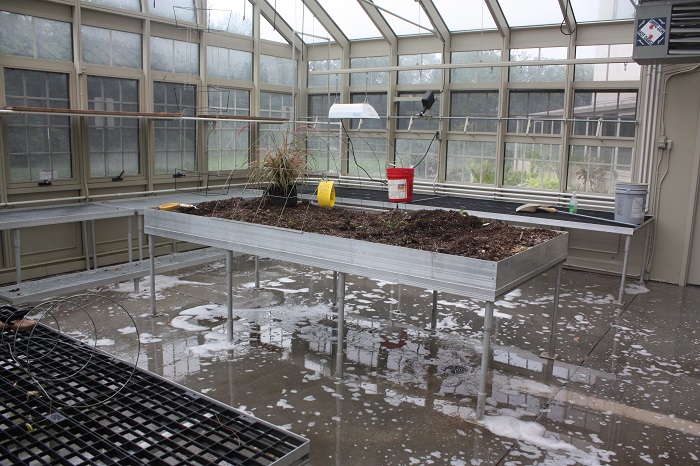Everyone has heard of spring cleaning, but I prefer summer cleaning for a greenhouse. Your greenhouse is always full of activity in spring and fall, then calm settles in during winter and the greenhouse is often emptied in summer. A lot of plants enjoy being outside with natural rain, sunlight, and wind. If your greenhouse does not have cooling methods, it is probably emptied during the summer.

Many people move their plants to outside patios, gazebos, and the front porch. It can be amazing to see the difference rainwater makes in a plant’s growth. The extra wind will help deter bugs and the plants will grow under the sunlight. While the greenhouse is empty, it is the perfect time to thoroughly clean it.
Other growers have cooling in their greenhouses to control summer heat and the plants live indoors all twelve months. I oversee a greenhouse that is stocked year-round and during one summer I had an outbreak of whiteflies. They were everywhere, under every leaf of every plant it seemed. I simply could not control the pests. I decided to empty the greenhouse and sterilize it. It was time for summer cleaning to rid the plants of disease and pests.
This greenhouse is landlocked between two other greenhouses. I could not get the infected plants to the outside, without passing through another greenhouse and I was not willing to risk an outbreak in a second greenhouse. My solution was to pass each plant through a window. I have a handy helper who assists in the greenhouse, and he removed the hardware on the awning window and propped it open with a stick. We then proceeded to pass 200 plants through that one window. All the plants stayed on the sidewalk which attracted a lot of attention and positive comments from passersby.
The plants remained outside for about a month in hopes that the wind and rain would wash away the whiteflies. Some plants did much better after being exposed to the elements. A lot of the whiteflies disappeared, and the plants returned to healthy states. Unfortunately, the greenhouses are in full sun and some of the tropical plants got sunburn, but those leaves were removed and the majority of the plants continued to grow.
When all the plants are outside you should consider removing the benches in the greenhouse for cleaning. There will most likely be old soil trapped in the corners of the benches. Any raised beds should have the soil removed and replaced with fresh amounts. All the bottles in your potting bench can be removed and cleaned. We recycled all cardboard fertilizer boxes along with random junk that had accumulated. We wanted nothing left that could harbor mold or insects in the future.
Now that we had an empty greenhouse, it was time to clean and sterilize. Every inch of the greenhouse should be cleaned. Insects, mold, and dirt hide in corners along with every hair line crack. A good way to clean the greenhouse is to begin up high. Begin cleaning with the roof and windows so the water drains down the walls and onto the floor. Make sure to clean the window and vent screens as well as around any motors you have.
If you have a base wall, there will be dirt. There may be algae growing in the corners near the floor, where the space is darker and has poor air circulation. Hot water, soap and elbow grease will usually remove all unwanted substances. At times you may need something stronger, which undoubtedly you have in your household cleaning supplies. Make sure to hose down the cracks in your concrete foundation and grout lines. If you have a soil and gravel floor, pull the weeds. Try to get the floor as clean as possible, especially under the benches and in the corners.
After we cleaned the greenhouse, I decided to sterilize the greenhouse by baking it. Greenhouses are essentially large glass boxes that will overheat if not properly vented. Because germs and insects can be smaller than the eye can see I wanted to kill anything that may be growing. All the vents, windows and doors were closed, and the temperature rose inside the greenhouse. For a week the greenhouse was sealed tight, and the temperature rose well above a hundred degrees.
When the greenhouse is sufficiently baked, your plants can return. Before our plants returned to the greenhouse each one was inspected for whiteflies, scale, and mealy bugs. By this point the plants had been outside for several weeks and if I saw an insect on the plant it was composted. This was also the ideal time to thin out our plant collection. The more plants in the greenhouse, the greater the chance of an insect outbreak. Only our favorite and healthiest plants returned to the greenhouse. Over the winter we added very few plants to keep the plant collection under control. We wanted to keep space between each plant and not have them jammed up against one another. Plants stay healthier if they receive ample air circulation and can dry off quickly following a watering.
After a year the greenhouse plants were much healthier than they had been the previous year. Thinning out the plants, keeping the collection under control and strictly monitoring for insects greatly improved the health of the greenhouse. Cleanliness helps to maintain a healthy greenhouse. Washing your floor and sweeping it often removes old leaves and dirt. The cleaner you keep the greenhouse, the healthier your plants will be.
Lyndsey Roth is an experienced gardener and greenhouse grower.
Related Articles & Free Email Newsletter Sign Up
A Checklist for Keeping the Bugs Out of a Greenhouse
How to Choose the Right Size, Location, and Type of Greenhouse
Why Proper Ventilation Helps Create a Healthy Greenhouse




Comment here